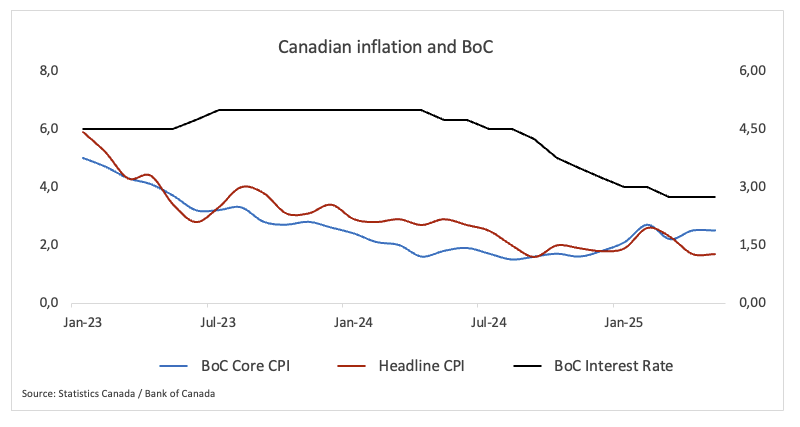- FXStreet expects the Bank of Canada to maintain unchanged rates on July 30.
- The Canadian Dollar maintains a positive tone vs. the US Dollar.
- The July meeting could be the fourth consecutive decision with rates at 2.75%.
- US tariffs would remain in the spotlight at Governor Macklem’s press conference.
As the Bank of Canada (BoC) gets set to issue a new interest rate decision on Wednesday, July 30, there is a growing sense that the cutting cycle might have already ended.
The BoC decided to keep rates steady in June, citing a Canadian economy that is “softer but not sharply weaker” and noting “firmness in recent inflation data.” Indeed, the policy rate stands at 2.75%, which remains within the bank’s estimated neutral range for interest rates, set between 2.25% and 3.25%.
President Donald Trump’s tariff agenda continues to be a significant global influence. Since his January return to the White House, he has dangled a slew of new levies that could ripple through global supply chains, and those threats will likely dominate Governor Tiff Macklem’s post‑meeting press conference.
The BoC’s Q2 Business Outlook Survey (BOS), out on July 21, indicated that Canadian firms are worried about the worst-case tariff situation but are still hesitant to hire and invest. The BOS revealed that companies’ short-term inflation predictions have returned to where they were a year ago, and businesses now see a recession scenario as less likely. Earlier this year, businesses were worried that US tariffs would hurt the economy, but so far the effects have mostly been seen in the steel, aluminium, and vehicle industries.
Consumers are feeling the economy’s slowdown in their own pay cheques, the latest Survey of Consumer Expectations shows. With the job market looking softer, more people say they’re uneasy about hanging on to their positions. This anxiety is permeating everyday life as households are reported to be tightening their budgets and altering their shopping habits as the trade war noise intensifies. While they don’t anticipate a surge in prices in the near future, many express concern that a new set of tariffs could hinder the central bank’s ability to control inflation.

Previewing the BoC’s interest rate decision, analyst Taylor Schleich at the National Bank of Canada noted, “There’s growing momentum around the idea that the easing cycle is over. We disagree, and we don’t expect the Governing Council to validate this more hawkish view. Instead, they’re likely to keep guidance unchanged, reiterating that they’re proceeding carefully and monitoring the same four indicators: export demand; tariff impacts on investment, employment, and spending; inflation; and inflation expectations.”
When will the BoC release its monetary policy decision, and how could it affect USD/CAD?
The Bank of Canada will publish its policy decision on Wednesday at 13:45 GMT alongside its Monetary Policy Report (MPR). After that, Governor Tiff Macklem will attend a press conference at 14:30 GMT.
Most economists expect the Bank of Canada (BoC) to keep its policy rate anchored at 2.75% on July 30, extending the pause begun in May and June. The decision arrives as the Canadian Dollar quietly grinds higher, rebounding from winter lows near 1.4800 vs. its American counterpart to the current vicinity of 1.3700.
Pablo Piovano, a Senior Analyst at FXStreet, said that “USD/CAD maintains its rebound from the area of yearly in the 1.3550-1.3540 range. While below its key 200-day Simple Moving Average (SMA) at 1.4038, the bearish scenario is expected to prevail.”
“USD/CAD hit a new YTD bottom of 1.3538 on June 16. Once this level is cleared, more losses could go all the way down to the September 2024 floor of 1.3418 (September 25),” Piovano said.
Piovano adds that “on the upside, the pair should run into initial resistance at its June ceiling of 1.3797 set on June 23, prior to the May peak of 1.4015 reached on May 12.”
The Relative Strength Index (RSI) has rebounded beyond the 52 level, which means that further upside appears on the cards over a short-term horizon. Piovano ends by saying, “The Average Directional Index (ADX) below 15 also shows that the trend lacks conviction.”
